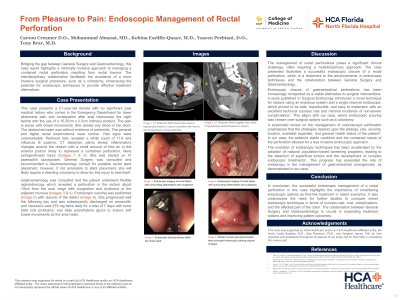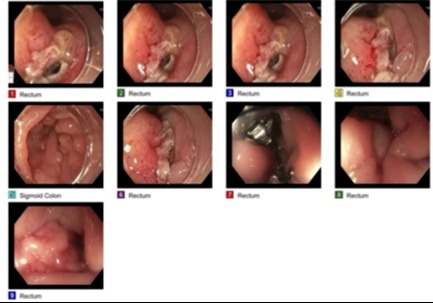Sunday Poster Session
Category: Interventional Endoscopy
P1086 - From Pleasure to Pain: Endoscopic Management of Post-Traumatic Rectal Perforation
Sunday, October 27, 2024
3:30 PM - 7:00 PM ET
Location: Exhibit Hall E

Has Audio

Carson Creamer, MD
University of Central Florida College of Medicine
Gainesville, FL
Presenting Author(s)
Carson Creamer, MD1, Tony S.. Brar, MD1, Mohammad Abu Assi, MD2, Kobina EssilfieQuaye, MD2, Yaseen Perbtani, DO2
1University of Central Florida College of Medicine, Gainesville, FL; 2University of Central Florida, HCA Healthcare GME, Gainesville, FL
Introduction: Bridging the gap between General Surgery and Gastroenterology, this case report highlights a minimally invasive approach to managing a contained rectal perforation resulting from rectal trauma. The interdisciplinary collaboration facilitated the avoidance of a more invasive surgical procedure, showcasing the potential for endoscopic techniques to provide effective treatment alternatives.
Case Description/Methods: This case presents a 51-year-old female with no significant past medical history who comes to the ED for abdominal pain and constipation after anal intercourse with the use of a 15 x 2.5cm intimacy product. CT abdomen pelvis shows inflammatory changes around the rectum with a small amount of free air in the anterior portion likely to represent a contained perforation. General Surgery was consulted and recommended a Gastroenterology consult or else would otherwise require a diverting colostomy to allow this injury to heal itself. Gastroenterology was consulted and the patient underwent flexible sigmoidoscopy which revealed a perforation in the rectum 10cm from the anal verge with congestion and erythema of the adjacent mucosa. Endoscopic suturing was performed with the closure of the defect. She progressed well the following day and was subsequently discharged.
Discussion: The management of rectal perforations poses a significant clinical challenge, often requiring a multidisciplinary approach. The case presented illustrates a successful endoscopic closure of a rectal perforation, which is a testament to the advancements in endoscopic techniques and the collaboration between General Surgery and Gastroenterology.
Endoscopic closure of gastrointestinal perforations has been increasingly recognized as a viable alternative to surgical interventions. A study published in Surgical Endoscopy introduced a novel technique for closure using an endoloop system and a single-channel endoscope, which proved to be safe, reproducible, and easy to implement, with an excellent technical success rate and minimal incidence of non-severe complications. This aligns with our case, where endoscopic suturing was chosen over surgical options such as a colostomy.
The evolution of endoscopic techniques has been accelerated by the adoption of national population-based screening programs, leading to the detection of superficial tumors and the development of complex endoscopic treatments. This progress has expanded the role of endoscopy in the management of gastrointestinal emergencies, as demonstrated in our case.

Disclosures:
Carson Creamer, MD1, Tony S.. Brar, MD1, Mohammad Abu Assi, MD2, Kobina EssilfieQuaye, MD2, Yaseen Perbtani, DO2. P1086 - From Pleasure to Pain: Endoscopic Management of Post-Traumatic Rectal Perforation, ACG 2024 Annual Scientific Meeting Abstracts. Philadelphia, PA: American College of Gastroenterology.
1University of Central Florida College of Medicine, Gainesville, FL; 2University of Central Florida, HCA Healthcare GME, Gainesville, FL
Introduction: Bridging the gap between General Surgery and Gastroenterology, this case report highlights a minimally invasive approach to managing a contained rectal perforation resulting from rectal trauma. The interdisciplinary collaboration facilitated the avoidance of a more invasive surgical procedure, showcasing the potential for endoscopic techniques to provide effective treatment alternatives.
Case Description/Methods: This case presents a 51-year-old female with no significant past medical history who comes to the ED for abdominal pain and constipation after anal intercourse with the use of a 15 x 2.5cm intimacy product. CT abdomen pelvis shows inflammatory changes around the rectum with a small amount of free air in the anterior portion likely to represent a contained perforation. General Surgery was consulted and recommended a Gastroenterology consult or else would otherwise require a diverting colostomy to allow this injury to heal itself. Gastroenterology was consulted and the patient underwent flexible sigmoidoscopy which revealed a perforation in the rectum 10cm from the anal verge with congestion and erythema of the adjacent mucosa. Endoscopic suturing was performed with the closure of the defect. She progressed well the following day and was subsequently discharged.
Discussion: The management of rectal perforations poses a significant clinical challenge, often requiring a multidisciplinary approach. The case presented illustrates a successful endoscopic closure of a rectal perforation, which is a testament to the advancements in endoscopic techniques and the collaboration between General Surgery and Gastroenterology.
Endoscopic closure of gastrointestinal perforations has been increasingly recognized as a viable alternative to surgical interventions. A study published in Surgical Endoscopy introduced a novel technique for closure using an endoloop system and a single-channel endoscope, which proved to be safe, reproducible, and easy to implement, with an excellent technical success rate and minimal incidence of non-severe complications. This aligns with our case, where endoscopic suturing was chosen over surgical options such as a colostomy.
The evolution of endoscopic techniques has been accelerated by the adoption of national population-based screening programs, leading to the detection of superficial tumors and the development of complex endoscopic treatments. This progress has expanded the role of endoscopy in the management of gastrointestinal emergencies, as demonstrated in our case.

Figure: Flexible sigmoidoscopy revealed a perforation in the rectum about 10cm from the anal verge with congestion and erythema of the adjacent mucosa. Endoscopic suturing was performed with closure of the defect.
*This picture quality will be improved upon presentation if accepted*
*This picture quality will be improved upon presentation if accepted*
Disclosures:
Carson Creamer indicated no relevant financial relationships.
Tony Brar indicated no relevant financial relationships.
Mohammad Abu Assi indicated no relevant financial relationships.
Kobina EssilfieQuaye indicated no relevant financial relationships.
Yaseen Perbtani indicated no relevant financial relationships.
Carson Creamer, MD1, Tony S.. Brar, MD1, Mohammad Abu Assi, MD2, Kobina EssilfieQuaye, MD2, Yaseen Perbtani, DO2. P1086 - From Pleasure to Pain: Endoscopic Management of Post-Traumatic Rectal Perforation, ACG 2024 Annual Scientific Meeting Abstracts. Philadelphia, PA: American College of Gastroenterology.
